 W
WMountain biking is a sport of riding bicycles off-road, often over rough terrain, usually using specially designed mountain bikes. Mountain bikes share similarities with other bikes but incorporate features designed to enhance durability and performance in rough terrain, such as air or coil-sprung shocks used as suspension, larger and wider wheels and tyres, stronger frame materials, and mechanically or hydraulically actuated disc brakes. Mountain biking can generally be broken down into five distinct categories: cross country, trail riding, all mountain, downhill, and freeride.
 W
WMountain bike racing is the competitive cycle sport discipline of mountain biking held on off-road terrain. The Union Cycliste Internationale (UCI) recognised the discipline relatively late in 1990, when it sanctioned the world championships in Durango, Colorado. The first UCI Mountain Bike World Cup series took place in 1988. Its nine-race circuit covered two continents—Europe and North America—and was sponsored by Grundig. Cross-country racing was the only World Cup sport at this time. In 1993, a six-event downhill World Cup was introduced. In 1996, cross-country mountain biking events were added to the Olympic Games. In 2006, cross-country mountain biking events became part of the World Deaf Cycling Championships for the first time in San Francisco, USA.
 W
W27.5 mountain bikes, also called tweeners, are mountain bikes which use a large volume tire that is approximately 27.5 inches in diameter, 56 mm wide on an ISO 584 mm rim. The wheel size is also known as "650B", and is used as a "marketing term" by some manufacturers for their 27.5", the 650B has traditionally been a designation for a 26 inch diameter using the same ISO 584 mm rim used by French tandems, Porteurs and touring bicycles.
 W
WThe bunny hop or bunnyhop, is a bicycle trick that allows the rider to launch their bike into the air as if jumping off a ramp. The pedals on the bicycle seem to stick to the rider's feet as the bike becomes airborne, much like how a skateboard seems to stick to the feet of the skater performing an Ollie. While the bunny hop can be quite challenging to learn, once mastered it opens up a whole new level of riding opportunities for both BMX and mountain bike rider alike.
 W
WCold-weather biking or winter biking is the use of a bicycle during months when roads and paths are covered with ice, slush and snow. Cold weather cyclists face a number of challenges in near or below freezing temperatures. Urban commuters on city streets may have to deal with "[s]now, slush, salt, and sand", which can cause rust and damage to metal bike components. Slush and ice can jam derailleurs. Some cyclists may bike differently in winter, by "slow[ing] down on turns and brak[ing] gradually" in icy conditions. Gaining traction on snow and ice-covered roads can be difficult. Winter cyclists may use bikes with front and rear fenders, metal studded winter tires and flashing LED lights. Winter cyclists may wear layers of warm clothes and "ea[r], face, and han[d]" coverings may be used. Specialized winter bikes called fatbikes, which have wide, oversized tires that are typically inflated with low pressure, are used in snow trail riding and winter bike competitions.
 W
WCross-country (XC) cycling is a discipline of mountain biking. Cross-country cycling became an Olympic sport in 1996 and is the only form of mountain biking practiced at the Olympics.
 W
WDirt jumping is the practice of riding bikes over jumps made of dirt or soil and becoming airborne. Dirt Jumping evolved alongside BMX racing and is similar to BMX or Mountain bike racing in that the rider jumps off of mounds of dirt, usually performing a midair trick in between. It differs in that the jumps are usually much larger and designed to lift the rider higher into the air. Additionally, the goal is not to complete the course with the fastest time, but rather to perform the best tricks with the best style. But dirt Jumpers are not Off-road BMX’s.
 W
WA downhill bike is a full suspension bicycle designed for downhill cycling on particularly steep, technical trails. Unlike a typical mountain bike, durability and stability are the most important design features, compared to lighter, more versatile cross-country bikes. Downhill bikes are primarily intended for high speed descent, and downhill riders will usually push, or shuttle via chairlifts or motorized vehicles, to the trailhead. Downhill bikes share similarities with freeride bikes due to their large strong frames and increased travel.
 W
WDownhill mountain biking (DH) is a genre of mountain biking practiced on steep, rough terrain that often features jumps, drops, rock gardens and other obstacles.
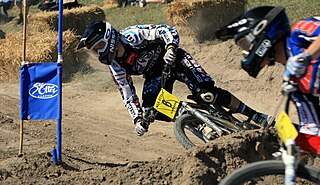 W
WDual slalom is an older mountain bike racing discipline similar to 4X racing.
 W
WEnduro in its most basic definition is a type of mountain bike racing where the downhills are timed, and the uphills are mandatory but not timed. Riders are timed in stages that are primarily downhill, with neutral "transfer" stages in between. The transfer stages usually must be completed within a time-limit, but are not part of the accumulated time.
 W
WIn mountain biking and skiing, a fall line refers to the line down a mountain or hill which is most directly downhill; that is, the direction a ball or other body would accelerate if it were free to move on the slope under gravity. In mountain biking, a trail follows the "fall line" if it generally descends in the most downward direction, rather than traversing in a sideways direction. A skier is said to be "skiing the fall line" if he or she is moving generally down, making turns either side of the fall line, rather than moving across the slope. Mathematically the fall line, the line of greatest slope, is the negative of the gradient and perpendicular to the contour lines.
 W
WFarlow Gap is a popular trail for mountain biking and hiking, located in the western area of North Carolina. It is an expert-level trail, and considered "one of the toughest mountain bike trails in Pisgah National Forest." It is primarily a downhill trail, about 3.1 miles (5.0 km) in length. It can be combined with other trails to form a loop of about 14 miles (23 km), requiring anywhere from three to six hours to complete.
 W
WA fatbike is an off-road bicycle with oversized tires, typically 3.8 in (97 mm) or larger and rims 2.16 in (55 mm) or wider, designed for low ground pressure to allow riding on soft, unstable terrain, such as snow, sand, bogs and mud. Fatbikes are built around frames with wide forks and stays to accommodate the wide rims required to fit these tires. The wide tires can be used with inflation pressures as low as 340 hPa; 0.34 bar (5 psi) to allow for a smooth ride over rough obstacles. A rating of 550–690 hPa; 0.55–0.69 bar (8–10 psi) is suitable for the majority of riders. Fatbikes were invented for use in snow and sand, but are capable of traversing diverse terrain types including snow, sand, desert, bogs, mud, pavement, or traditional mountain biking trails. The sport is sometimes referred to as fatbiking or fat-tire biking.
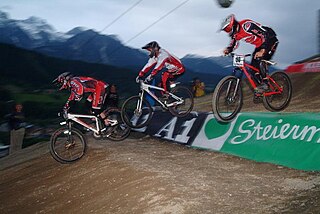 W
WFour-cross (4X), also called mountain-cross, not to be confused with fourcross, is a relatively new style of mountain bike racing where four bikers race downhill on a prepared, BMX-like track, simply trying to get down first. These bikes are generally either full suspension with 140mm to 160mm of travel, or hardtails, and typically have relatively strong frames. They run a chainguide on front and gears on the back. They have slack head angles, short chainstays and low bottom brackets for good cornering and acceleration. In recent years the tracks raced on have been rougher and less like those used in BMX.
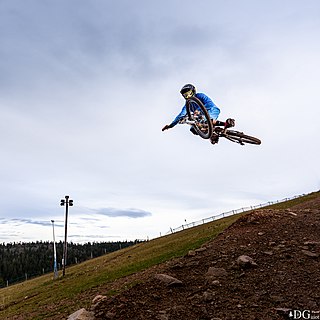 W
WFreeride is a discipline of mountain biking closely related to downhill biking and dirt jumping focused on tricks, style, and technical trail features. It is now recognized as one of the most popular disciplines within mountain biking.
 W
WThis is a glossary of terms and jargon used in cycling, mountain biking, and cycle sport.
 W
WThe International Mountain Bicycling Association (IMBA) is a non-profit educational association whose mission is to create, enhance and preserve trail opportunities for mountain bikers worldwide.
 W
WA mountain bike (MTB) or mountain bicycle is a bicycle designed for off-road cycling. Mountain bikes share some similarities with other bicycles, but incorporate features designed to enhance durability and performance in rough terrain. These typically include a suspension fork, large knobby tires, more durable wheels, more powerful brakes, straight, extra wide handlebars to improve balance and comfort over rough terrain, lower gear-ratios for climbing steep grades and sometimes rear suspension to really smooth out the trail.
 W
WMountain bike orienteering is an orienteering endurance racing sport on a mountain bike where navigation is done along trails and tracks. Compared with foot orienteering, competitors usually are not permitted to leave the trail and track network. Navigation tactics are similar to ski-orienteering, where the major focus is route choice while navigating. The main difference compared to ski-orienteering is that navigation is done at a higher pace, because the bike can reach higher speeds. As the biker reaches higher speeds, map reading becomes more challenging.
 W
WMountain bike trials, also known as observed trials, is a discipline of mountain biking in which the rider attempts to pass through an obstacle course without setting foot to ground. Derived from motorcycle trials, it originated in Catalonia, Spain as trialsín and is said to have been invented by the father of Ot Pi, a world champion motorcycle trials rider. Pi's father had wanted his son to learn motorcycle trials by practicing on an ordinary bicycle.
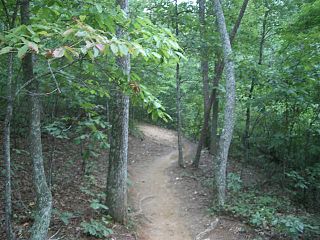 W
WSingletrack describes a type of mountain biking trail that is approximately the width of the bike. It contrasts with double-track or fire road which is wide enough for four-wheeled off-road vehicles. It is often smooth and flowing, but may also feature technical rocky sections, go over tree roots, and include berms, banked turns, switch-backs, hills, drops, jumps, and so forth. Singletrack which descends significantly, and in the most downward direction, is said to be following the fall line.
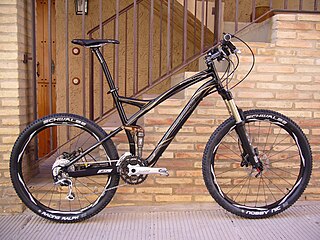 W
WThe Specialized Stumpjumper is a mountain bike produced by Specialized Bicycle Components. When it was first produced in 1981, the Stumpjumper was the first mass-production mountain bike. The Stumpjumper is still in production, although its design has changed significantly since it was first sold. Stumpjumpers have been raced professionally by riders including Christoph Sauser and Ned Overend.
 W
WTrail riding is riding outdoors on trails, bridle paths, and forest roads, but not on roads regularly used by motorised traffic. A trail ride can be of any length, including a long distance, multi-day trip. It originated with horse riding, and in North America, the equestrian form is usually called "trail riding," or, less often "hacking." In the UK and Europe, the practice is usually called horse or pony trekking.
 W
WWinter triathlon is a multisport event involving the continuous and sequential completion of snowshoeing or running, mountain biking or speed skating and cross-country skiing, all on snow. Course distances are set on the day of the event to achieve a winning time around 80–90 minutes, after taking account of the snow conditions.